check engine JEEP RENEGADE 2016 1.G Owner's Manual
[x] Cancel search | Manufacturer: JEEP, Model Year: 2016, Model line: RENEGADE, Model: JEEP RENEGADE 2016 1.GPages: 688, PDF Size: 7.09 MB
Page 547 of 688
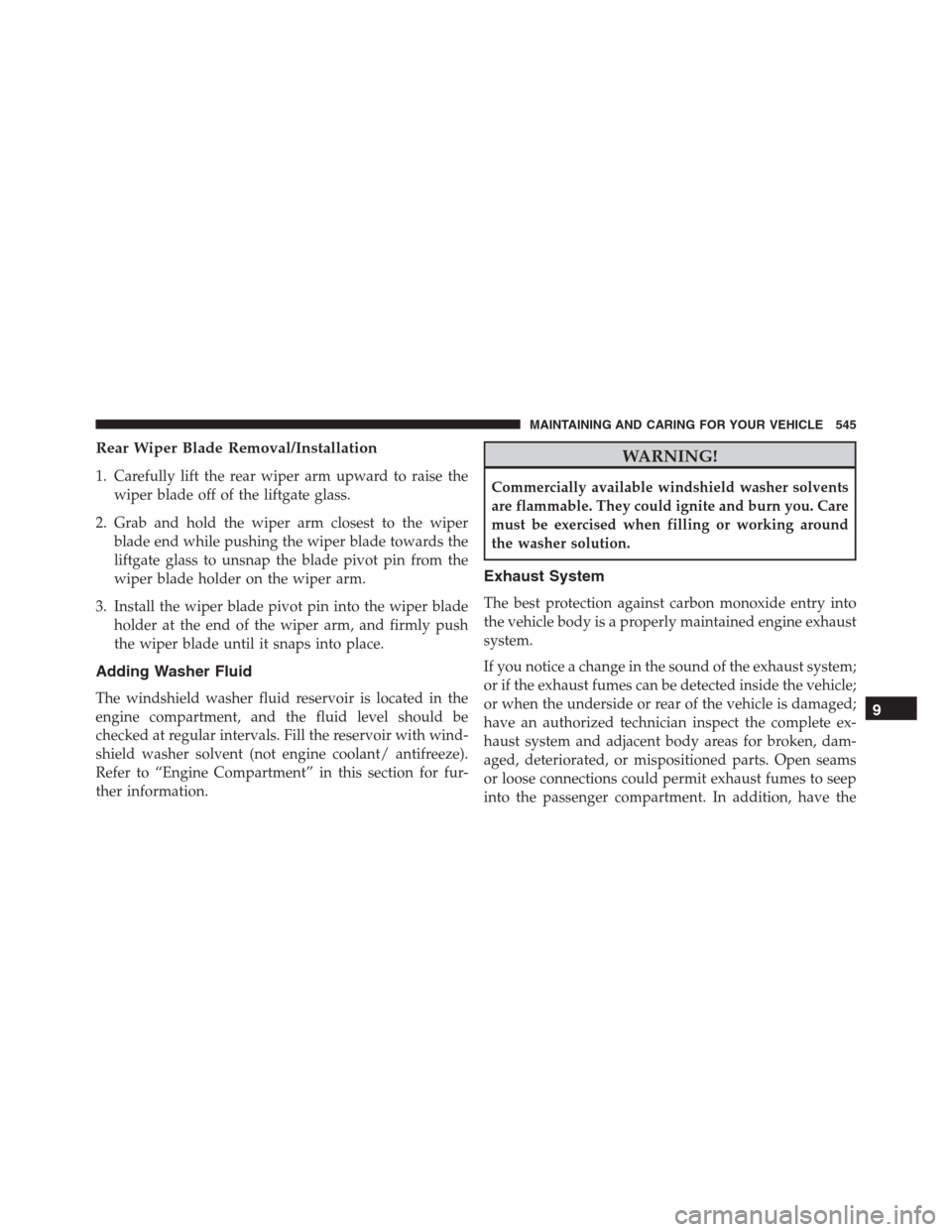
Rear Wiper Blade Removal/Installation
1. Carefully lift the rear wiper arm upward to raise the
wiper blade off of the liftgate glass.
2. Grab and hold the wiper arm closest to the wiper
blade end while pushing the wiper blade towards the
liftgate glass to unsnap the blade pivot pin from the
wiper blade holder on the wiper arm.
3. Install the wiper blade pivot pin into the wiper blade
holder at the end of the wiper arm, and firmly push
the wiper blade until it snaps into place.
Adding Washer Fluid
The windshield washer fluid reservoir is located in the
engine compartment, and the fluid level should be
checked at regular intervals. Fill the reservoir with wind-
shield washer solvent (not engine coolant/ antifreeze).
Refer to “Engine Compartment” in this section for fur-
ther information.
WARNING!
Commercially available windshield washer solvents
are flammable. They could ignite and burn you. Care
must be exercised when filling or working around
the washer solution.
Exhaust System
The best protection against carbon monoxide entry into
the vehicle body is a properly maintained engine exhaust
system.
If you notice a change in the sound of the exhaust system;
or if the exhaust fumes can be detected inside the vehicle;
or when the underside or rear of the vehicle is damaged;
have an authorized technician inspect the complete ex-
haust system and adjacent body areas for broken, dam-
aged, deteriorated, or mispositioned parts. Open seams
or loose connections could permit exhaust fumes to seep
into the passenger compartment. In addition, have the
9
MAINTAINING AND CARING FOR YOUR VEHICLE 545
Page 550 of 688
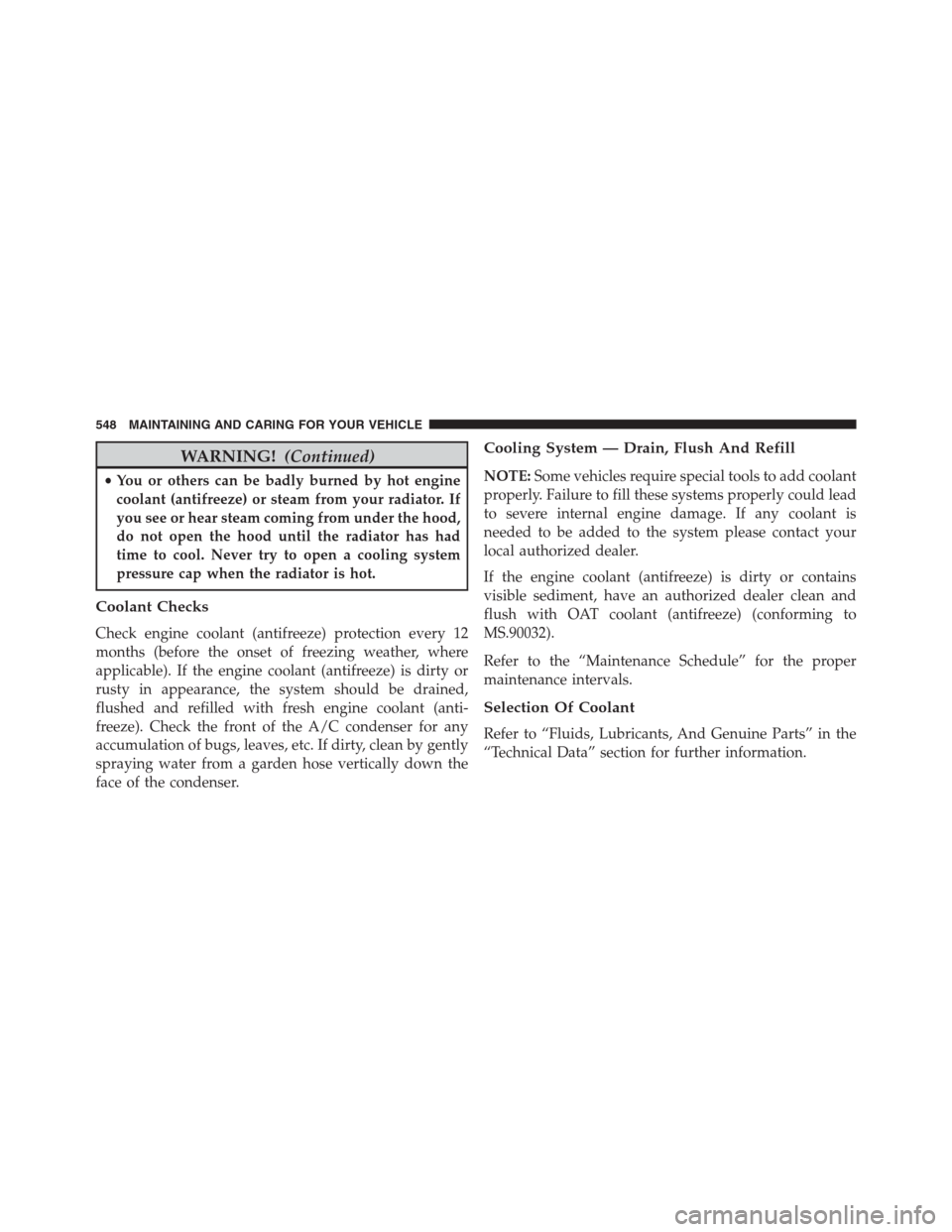
WARNING!(Continued)
•You or others can be badly burned by hot engine
coolant (antifreeze) or steam from your radiator. If
you see or hear steam coming from under the hood,
do not open the hood until the radiator has had
time to cool. Never try to open a cooling system
pressure cap when the radiator is hot.
Coolant Checks
Check engine coolant (antifreeze) protection every 12
months (before the onset of freezing weather, where
applicable). If the engine coolant (antifreeze) is dirty or
rusty in appearance, the system should be drained,
flushed and refilled with fresh engine coolant (anti-
freeze). Check the front of the A/C condenser for any
accumulation of bugs, leaves, etc. If dirty, clean by gently
spraying water from a garden hose vertically down the
face of the condenser.
Cooling System — Drain, Flush And Refill
NOTE:Some vehicles require special tools to add coolant
properly. Failure to fill these systems properly could lead
to severe internal engine damage. If any coolant is
needed to be added to the system please contact your
local authorized dealer.
If the engine coolant (antifreeze) is dirty or contains
visible sediment, have an authorized dealer clean and
flush with OAT coolant (antifreeze) (conforming to
MS.90032).
Refer to the “Maintenance Schedule” for the proper
maintenance intervals.
Selection Of Coolant
Refer to “Fluids, Lubricants, And Genuine Parts” in the
“Technical Data” section for further information.
548 MAINTAINING AND CARING FOR YOUR VEHICLE
Page 553 of 688
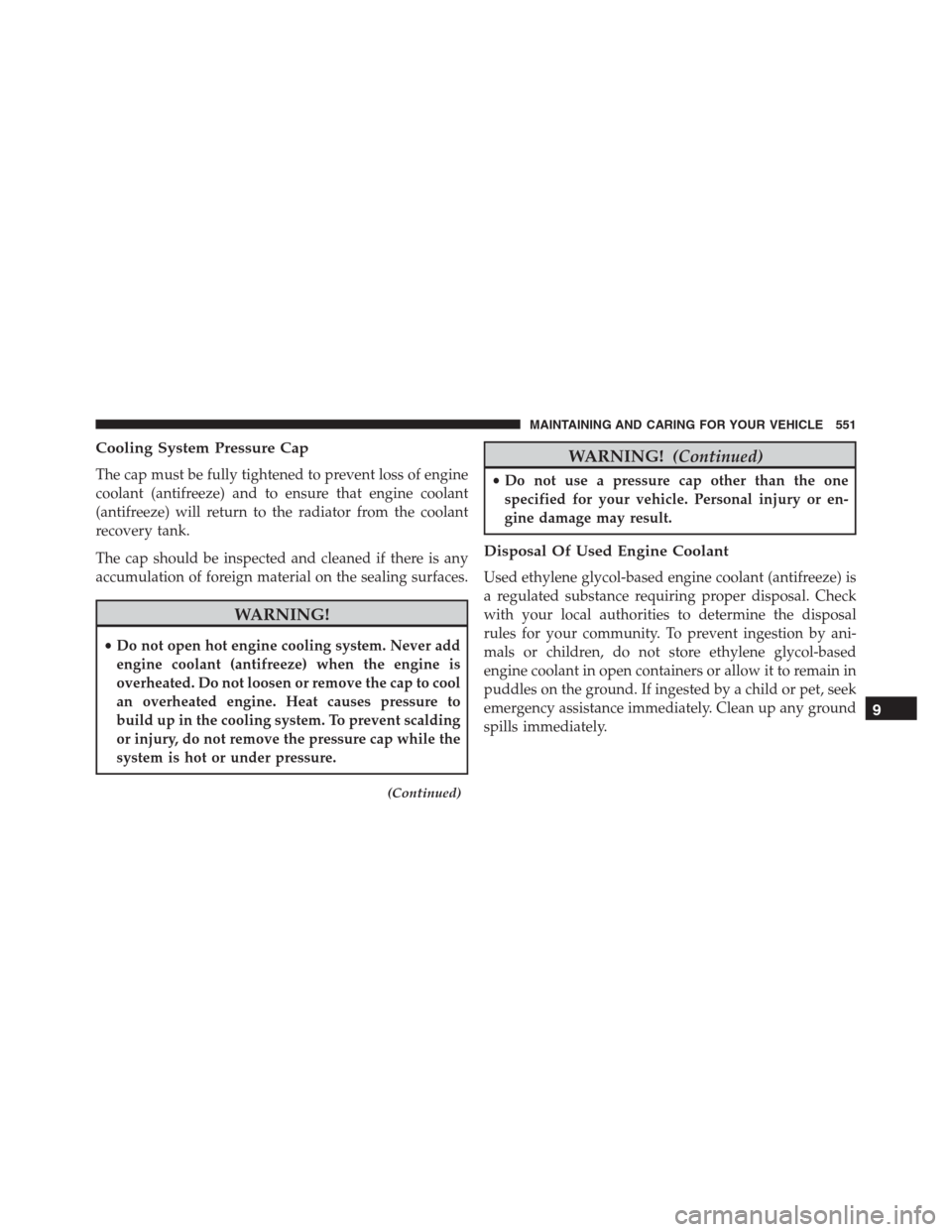
Cooling System Pressure Cap
The cap must be fully tightened to prevent loss of engine
coolant (antifreeze) and to ensure that engine coolant
(antifreeze) will return to the radiator from the coolant
recovery tank.
The cap should be inspected and cleaned if there is any
accumulation of foreign material on the sealing surfaces.
WARNING!
•Do not open hot engine cooling system. Never add
engine coolant (antifreeze) when the engine is
overheated. Do not loosen or remove the cap to cool
an overheated engine. Heat causes pressure to
build up in the cooling system. To prevent scalding
or injury, do not remove the pressure cap while the
system is hot or under pressure.
(Continued)
WARNING!(Continued)
•Do not use a pressure cap other than the one
specified for your vehicle. Personal injury or en-
gine damage may result.
Disposal Of Used Engine Coolant
Used ethylene glycol-based engine coolant (antifreeze) is
a regulated substance requiring proper disposal. Check
with your local authorities to determine the disposal
rules for your community. To prevent ingestion by ani-
mals or children, do not store ethylene glycol-based
engine coolant in open containers or allow it to remain in
puddles on the ground. If ingested by a child or pet, seek
emergency assistance immediately. Clean up any ground
spills immediately.
9
MAINTAINING AND CARING FOR YOUR VEHICLE 551
Page 554 of 688
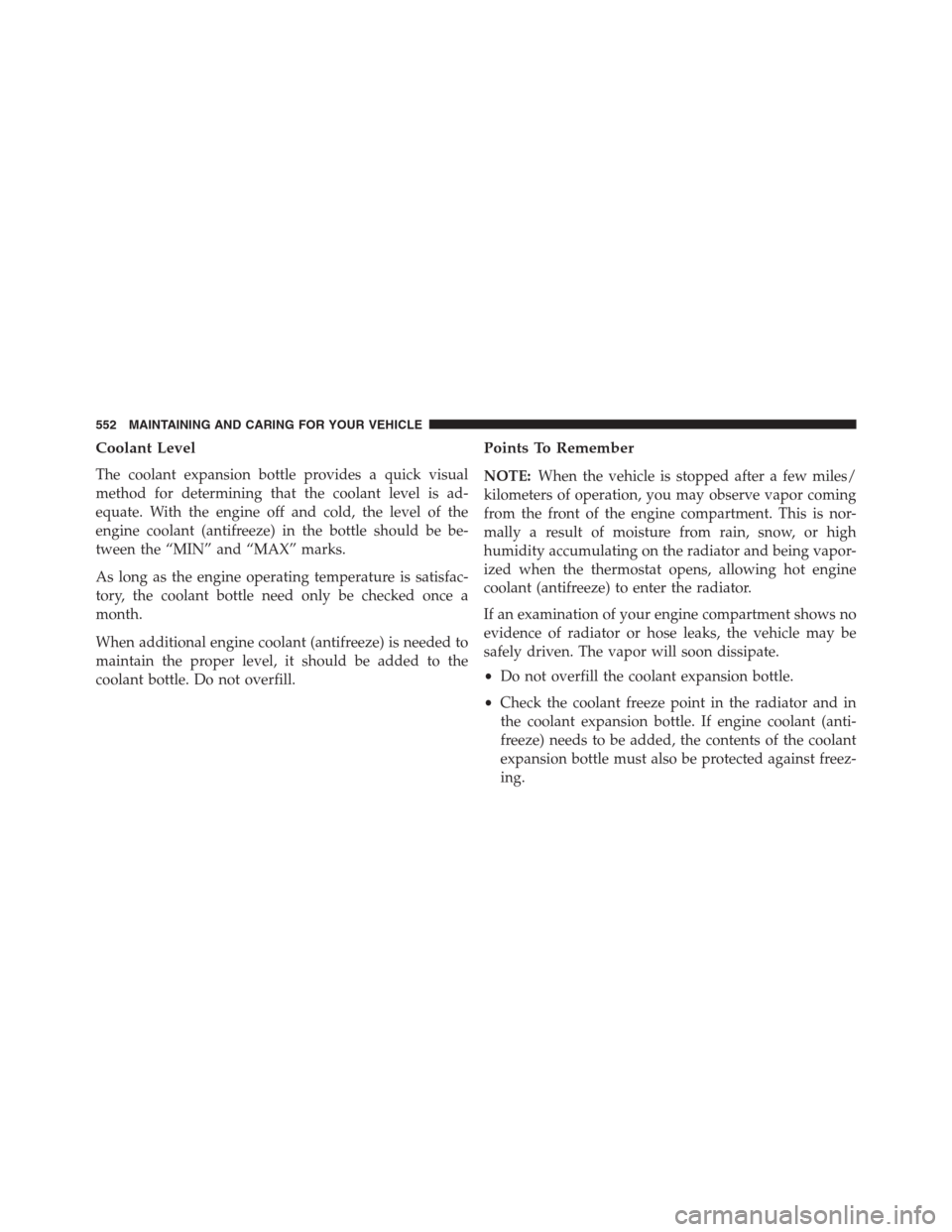
Coolant Level
The coolant expansion bottle provides a quick visual
method for determining that the coolant level is ad-
equate. With the engine off and cold, the level of the
engine coolant (antifreeze) in the bottle should be be-
tween the “MIN” and “MAX” marks.
As long as the engine operating temperature is satisfac-
tory, the coolant bottle need only be checked once a
month.
When additional engine coolant (antifreeze) is needed to
maintain the proper level, it should be added to the
coolant bottle. Do not overfill.
Points To Remember
NOTE:When the vehicle is stopped after a few miles/
kilometers of operation, you may observe vapor coming
from the front of the engine compartment. This is nor-
mally a result of moisture from rain, snow, or high
humidity accumulating on the radiator and being vapor-
ized when the thermostat opens, allowing hot engine
coolant (antifreeze) to enter the radiator.
If an examination of your engine compartment shows no
evidence of radiator or hose leaks, the vehicle may be
safely driven. The vapor will soon dissipate.
•Do not overfill the coolant expansion bottle.
•Check the coolant freeze point in the radiator and in
the coolant expansion bottle. If engine coolant (anti-
freeze) needs to be added, the contents of the coolant
expansion bottle must also be protected against freez-
ing.
552 MAINTAINING AND CARING FOR YOUR VEHICLE
Page 555 of 688
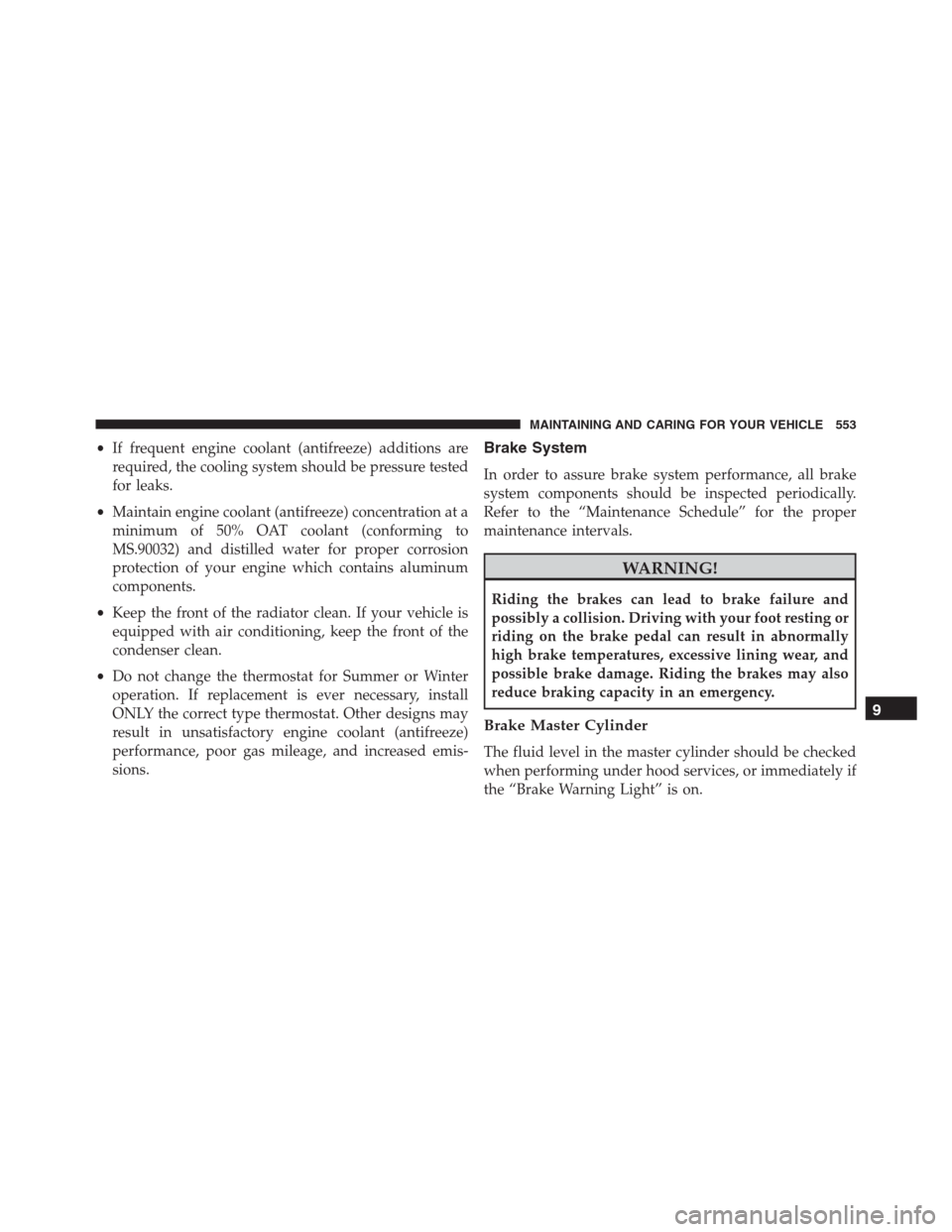
•If frequent engine coolant (antifreeze) additions are
required, the cooling system should be pressure tested
for leaks.
•Maintain engine coolant (antifreeze) concentration at a
minimum of 50% OAT coolant (conforming to
MS.90032) and distilled water for proper corrosion
protection of your engine which contains aluminum
components.
•Keep the front of the radiator clean. If your vehicle is
equipped with air conditioning, keep the front of the
condenser clean.
•Do not change the thermostat for Summer or Winter
operation. If replacement is ever necessary, install
ONLY the correct type thermostat. Other designs may
result in unsatisfactory engine coolant (antifreeze)
performance, poor gas mileage, and increased emis-
sions.Brake System
In order to assure brake system performance, all brake
system components should be inspected periodically.
Refer to the “Maintenance Schedule” for the proper
maintenance intervals.
WARNING!
Riding the brakes can lead to brake failure and
possibly a collision. Driving with your foot resting or
riding on the brake pedal can result in abnormally
high brake temperatures, excessive lining wear, and
possible brake damage. Riding the brakes may also
reduce braking capacity in an emergency.
Brake Master Cylinder
The fluid level in the master cylinder should be checked
when performing under hood services, or immediately if
the “Brake Warning Light” is on.
9
MAINTAINING AND CARING FOR YOUR VEHICLE 553
Page 559 of 688
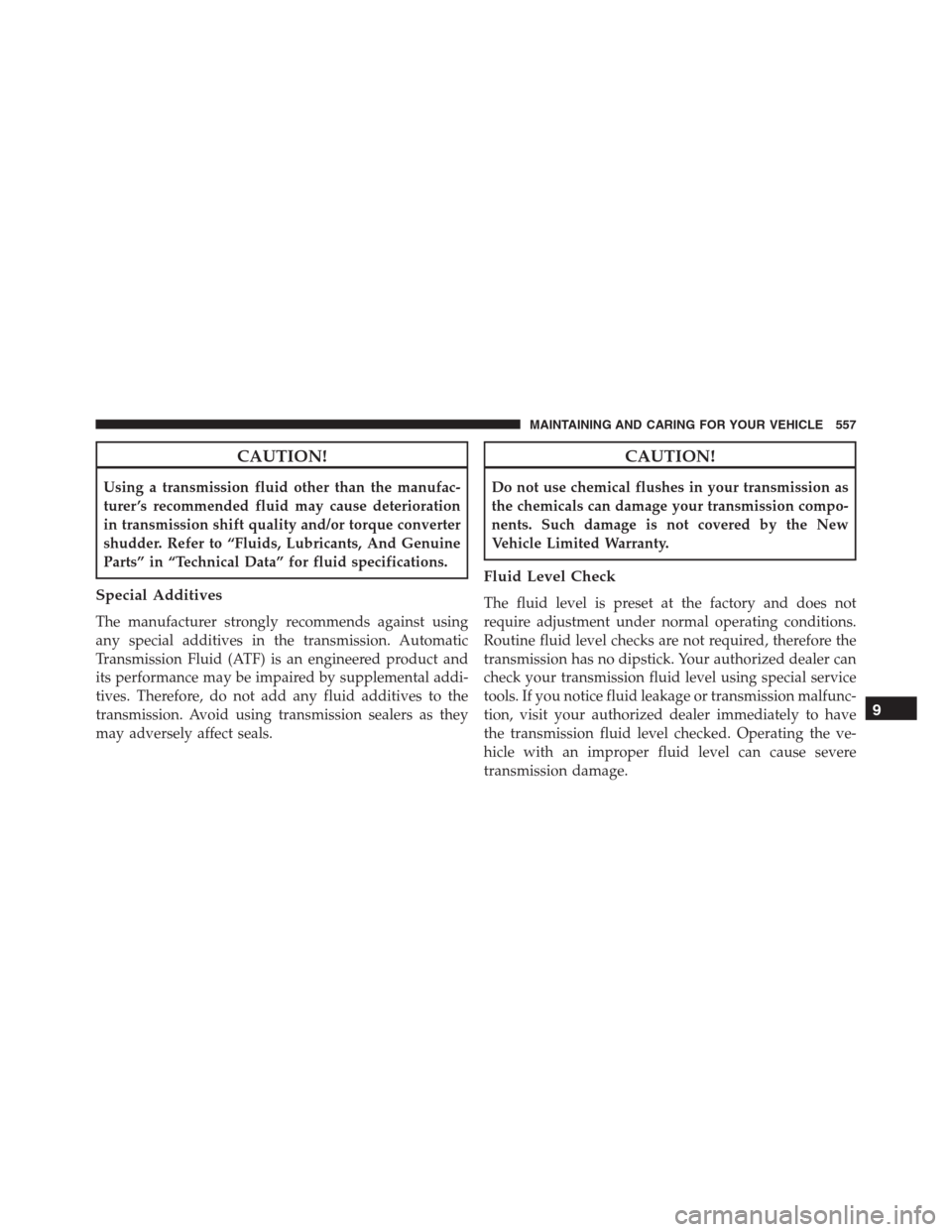
CAUTION!
Using a transmission fluid other than the manufac-
turer ’s recommended fluid may cause deterioration
in transmission shift quality and/or torque converter
shudder. Refer to “Fluids, Lubricants, And Genuine
Parts” in “Technical Data” for fluid specifications.
Special Additives
The manufacturer strongly recommends against using
any special additives in the transmission. Automatic
Transmission Fluid (ATF) is an engineered product and
its performance may be impaired by supplemental addi-
tives. Therefore, do not add any fluid additives to the
transmission. Avoid using transmission sealers as they
may adversely affect seals.
CAUTION!
Do not use chemical flushes in your transmission as
the chemicals can damage your transmission compo-
nents. Such damage is not covered by the New
Vehicle Limited Warranty.
Fluid Level Check
The fluid level is preset at the factory and does not
require adjustment under normal operating conditions.
Routine fluid level checks are not required, therefore the
transmission has no dipstick. Your authorized dealer can
check your transmission fluid level using special service
tools. If you notice fluid leakage or transmission malfunc-
tion, visit your authorized dealer immediately to have
the transmission fluid level checked. Operating the ve-
hicle with an improper fluid level can cause severe
transmission damage.
9
MAINTAINING AND CARING FOR YOUR VEHICLE 557
Page 595 of 688

•If you do not disconnect the battery from the electrical
system, check the battery charge every thirty days.
•Clean and protect the painted parts by applying pro-
tective waxes.
•Clean and protect polished metal parts by applying
protective waxes.
•Apply talcum powder to the front and rear wiper
blades and leave raised from the glass.
•Cover the vehicle with an appropriate cover taking
care not to damage the painted surface by dragging
across dirty surfaces. Do not use plastic sheeting which
will not allow the evaporation of moisture present on
the surface of the vehicle.
•Inflate the tires at a pressure of +7.25 psi (+0.5 bar) is
higher than recommended on the tire placard and
check it periodically.•Do not drain the engine cooling system.
•Whenever you leave the vehicle is stationary for two
weeks or more, run the at engine idling and for
approximately five minutes, with the air conditioning
system on and high fan speed. This will ensure a
proper lubrication of the system, thus minimizing the
possibility of damage to the compressor when the
vehicle is put back into operation.
CAUTION!
Before removal of the positive and negative terminals
to the battery, wait at least a minute with ignition
switch in the OFF position and close the drivers door.
When reconnecting the positive and negative terminals
to the battery be sure the ignition switch is in the OFF
position and the drivers door is closed.
9
MAINTAINING AND CARING FOR YOUR VEHICLE 593
Page 670 of 688

Bulbs, Light.............................316
Camera, Rear............................386
Capacities, Fluid..........................600
Caps, Filler
Oil (Engine)...........................537
Carbon Monoxide Warning...............313, 405
Car Washes.............................559
Certification Label.........................409
Changing A Flat Tire....................483, 565
Chart, Tire Sizing.........................568
Check Engine Light (Malfunction Indicator Light) . .522
Checking Your Vehicle For Safety..............312
Checks, Safety...........................312
Child Restraint...........................291
Child Restraints
Booster Seats..........................296
Child Restraints........................291
Child Seat Installation....................309How To Stow An Unused ALR Seat Belt.......305
Infants And Child Restraints...............294
Install A LATCH-Compatible Child Restraint. . . .304
Installing Child Restraints Using The Vehicle
Seat Belt..............................306
LATCH Positions.......................299
Locating The LATCH Anchorages............302
Lower Anchors And Tethers For Children......298
Older Children And Child Restraints.........294
Seating Positions........................297
Child Safety Locks.........................65
Clean Air Gasoline........................401
Cleaning
Wheels...............................560
Windshield Wiper Blades..................542
Climate Control..........................117
Automatic..................123, 127, 128, 134
Manual..............................117
Clutch.................................553
668 INDEX
Page 672 of 688
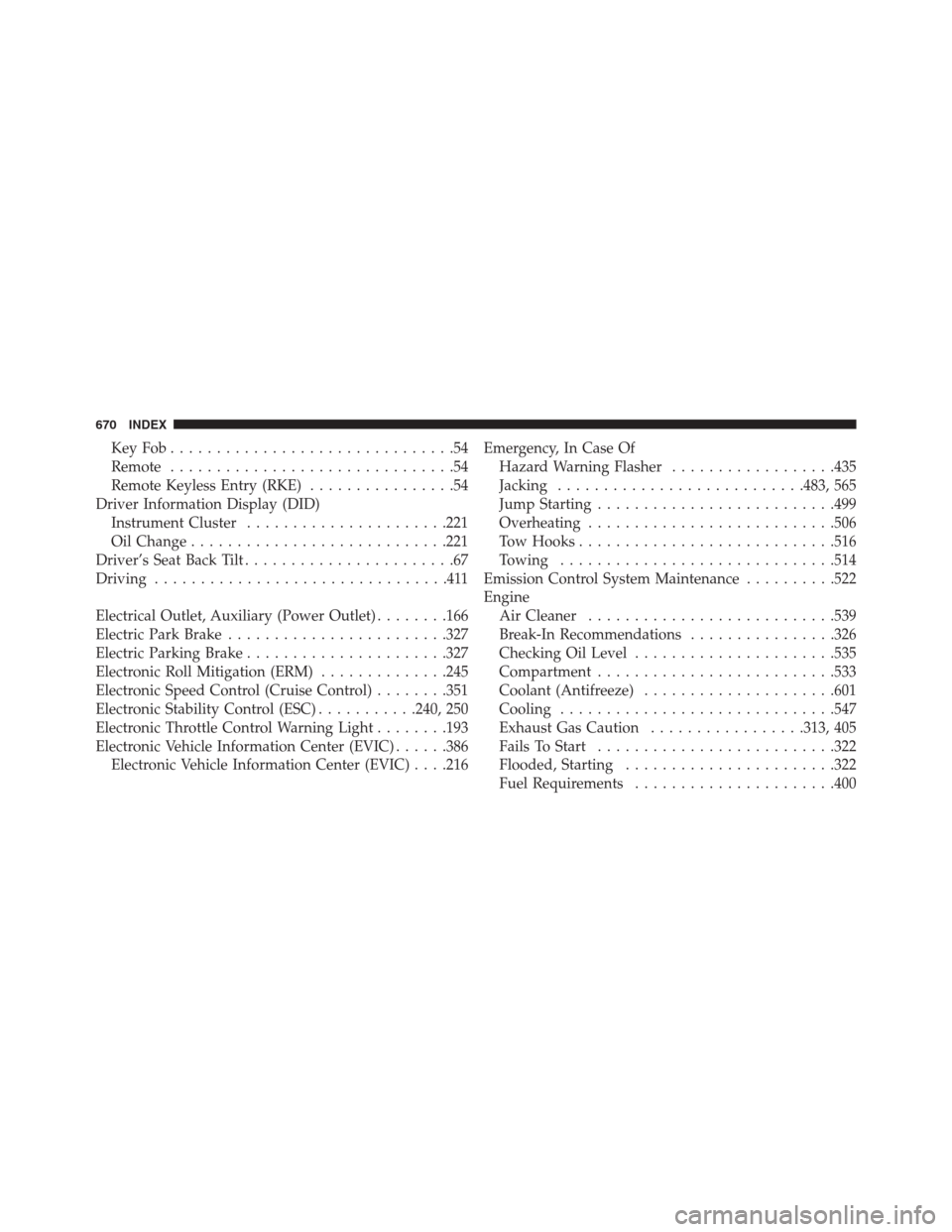
KeyFob...............................54
Remote...............................54
Remote Keyless Entry (RKE)................54
Driver Information Display (DID)
Instrument Cluster......................221
Oil Change............................221
Driver’s Seat Back Tilt.......................67
Driving................................411
Electrical Outlet, Auxiliary (Power Outlet)........166
Electric Park Brake........................327
Electric Parking Brake......................327
Electronic Roll Mitigation (ERM)..............245
Electronic Speed Control (Cruise Control)........351
Electronic Stability Control (ESC)...........240, 250
Electronic Throttle Control Warning Light........193
Electronic Vehicle Information Center (EVIC)......386
Electronic Vehicle Information Center (EVIC). . . .216Emergency, In Case Of
Hazard Warning Flasher..................435
Jacking...........................483, 565
Jump Starting..........................499
Overheating...........................506
Tow Hooks............................516
Towing..............................514
Emission Control System Maintenance..........522
Engine
Air Cleaner...........................539
Break-In Recommendations................326
Checking Oil Level......................535
Compartment..........................533
Coolant (Antifreeze).....................601
Cooling..............................547
Exhaust Gas Caution.................313, 405
Fails To Start..........................322
Flooded, Starting.......................322
Fuel Requirements......................400
670 INDEX
Page 677 of 688
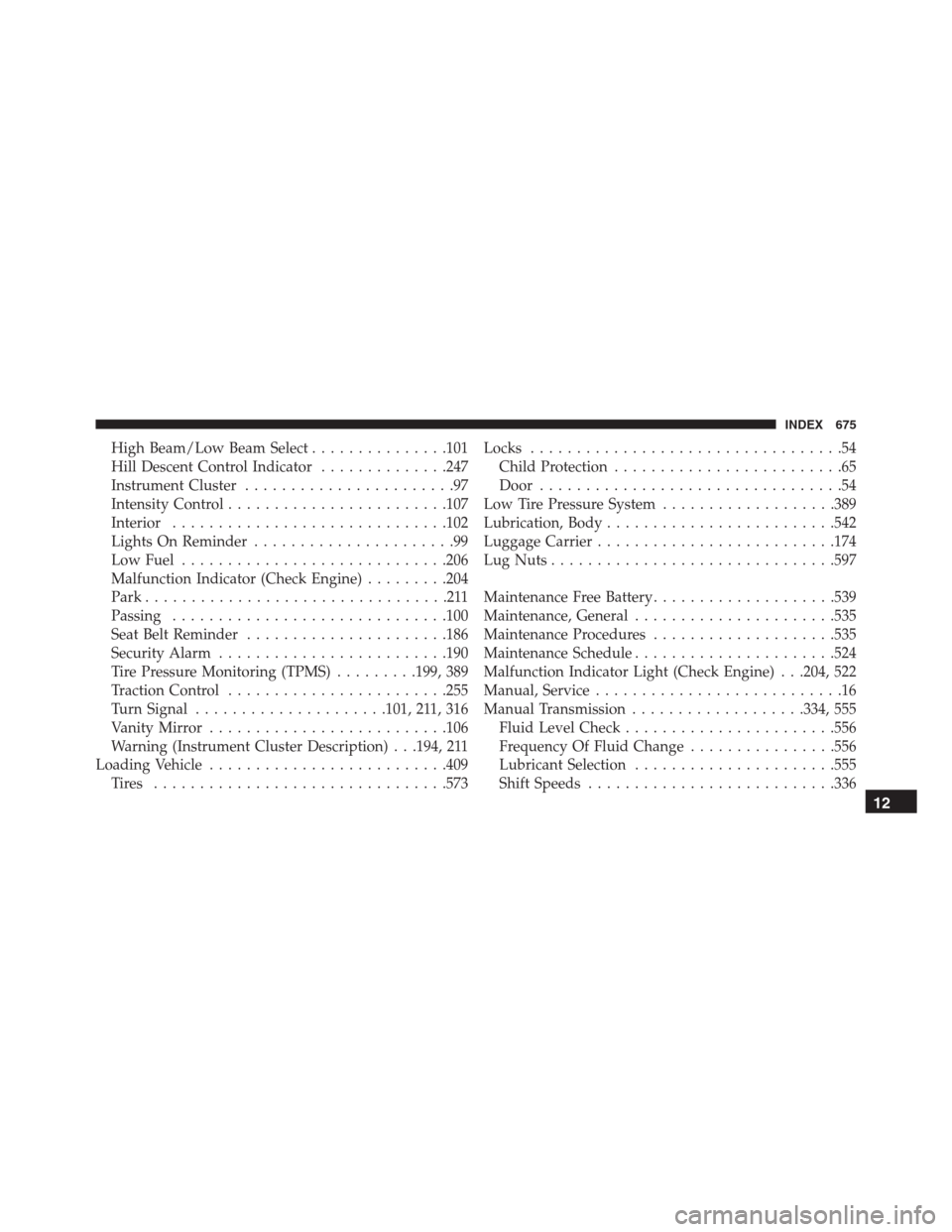
High Beam/Low Beam Select...............101
Hill Descent Control Indicator..............247
Instrument Cluster.......................97
Intensity Control........................107
Interior..............................102
Lights On Reminder......................99
Low Fuel.............................206
Malfunction Indicator (Check Engine).........204
Park.................................211
Passing..............................100
Seat Belt Reminder......................186
Security Alarm.........................190
Tire Pressure Monitoring (TPMS).........199, 389
Traction Control........................255
Turn Signal.....................101, 211, 316
Vanity Mirror..........................106
Warning (Instrument Cluster Description) . . .194, 211
Loading Vehicle..........................409
Tires ................................573Locks..................................54
Child Protection.........................65
Door.................................54
Low Tire Pressure System...................389
Lubrication, Body.........................542
Luggage Carrier..........................174
Lug Nuts...............................597
Maintenance Free Battery....................539
Maintenance, General......................535
Maintenance Procedures....................535
Maintenance Schedule......................524
Malfunction Indicator Light (Check Engine) . . .204, 522
Manual, Service...........................16
Manual Transmission...................334, 555
Fluid Level Check.......................556
Frequency Of Fluid Change................556
Lubricant Selection......................555
Shift Speeds...........................336
12
INDEX 675